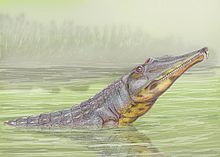Rutiodon
| Rutiodon Temporal range:
| |
|---|---|

| |
| Artists impression of Rutiodon validus | |
| Scientific classification | |
| Kingdom: | |
| Phylum: | |
| Class: | |
| (unranked): | |
| Order: | |
| Family: | |
| Genus: | Rutiodon Emmons, 1856
|
| Synonyms | |
| |
Rutiodon ("Wrinkle tooth") is an extinct genus of archosaur belonging to the family Phytosauridae. It lived during the Late Triassic period, and was about 10 to 25 feet (3 to 8 meters) in length.[1]. The animal is known from fossils in Europe (Germany and Switzerland) as well as North America (Arizona, New Mexico, North Carolina, Texas).
Like other phytosaurs, Rutiodon strongly resembled a crocodile, but its nostrils were positioned far back on the head, close to the eyes, instead of at the tip of the snout. It had enlarged front teeth, and a relatively narrow jaw, somewhat resembling that of a modern gharial. This suggests that this carnivore probably caught fish and it may also have snatched land animals from the waterside.[1] Also like modern crocodiles, its back, flanks, and tail were covered with bony armored plates.[2]
In popular culture
Rutiodon is one of the best-known phytosaurs and appeared in the 2001 Discovery Channel documentary When Dinosaurs Roamed America, shown trying to attack a Coelophysis near the water's edge and missing. Rutiodon was also featured in episode 6 of Animal Armageddon.
Gallery
-
Skeleton and dermal plates of Rutiodon manhattanensis
-
Rutiodon carolinensis fossil
-
Rutiodon manhattanensis fossil
-
Restoration of Rutiodon
References
- ^ a b Gaines, Richard M. (2001). Coelophysis. ABDO Publishing Company. p. 21. ISBN 1-57765-488-9.
- ^ Palmer, D., ed. (1999). The Marshall Illustrated Encyclopedia of Dinosaurs and Prehistoric Animals. London: Marshall Editions. p. 95. ISBN 1-84028-152-9.
- Geological report of the midland counties of North Carolina by Ebenezer Emmons. New York, G.P. Putnam & Co.; Raleigh, H.D. Turner, 1856.
- Rutiodon in The Dinosaur Encyclopaedia at Dino Russ's Lair.
- http://www.paleodirect.com/phyto1.htm
- http://www.dinosaurcollector.150m.com/NewBlood.html


